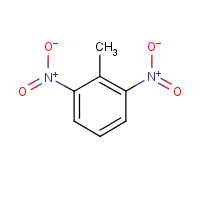2,6-Dinitrotoluene
Agent Name
2,6-Dinitrotoluene
CAS Number
606-20-2
Formula
C7-H6-N2-O4
Major Category
Nitrogen Compounds

Synonyms
1-Methyl-2,6-dinitrobenzene; 2,6-DNT; 2,6-Dinitromethylbenzene; 2-Methyl-1,3-dinitrobenzene; Benzene, 2-methyl-1,3-dinitro-; Toluene, 2,6-dinitro-; [ChemIDplus] UN3454; UN2038
Category
Nitros, Aromatic
Description
Yellow or brown to red solid; [ICSC] Pale yellow crystalline powder; [Alfa Aesar MSDS]
Sources/Uses
Used to make TNT, urethane polymers, flexible and rigid foams, surface coatings, dyes, and other chemicals; Also used as a gelatinizing and waterproofing agent for explosives; [HSDB]
Comments
Can induce methemoglobinemia; May be toxic to human reproduction or development, based on animal studies; [ICSC] Comprises approximately 19% of technical grade dinitrotoluene; [HSDB] A mild skin sensitizer in guinea pigs; Evidence suggests that dinitrotoluene isomers can be significantly absorbed through human skin; [DOE] An irritant; Toxic by ingestion, inhalation, and skin absorption; May cause cancer; Possible hazard of impaired fertility and irreversible effects; [Alfa Aesar MSDS] See "Dinitrotoluene, all isomers."
Biomedical References
Exposure Assessment
Vapor Pressure
0.000567 mm Hg
Lethal Concentration
LC50 (rat) = 240 mg/m3/6hr
Explanatory Notes
Vapor Pressure = 0.018 mm Hg at 20 deg C; [NTP] The Guide in the Emergency Response Guidebook is for "Dinitrotoluenes, solid." VP from ChemIDplus;
NFPA
must be preheated
Adverse Effects
Methemoglobinemia
MetHgb is secondary toxic effect
Hepatotoxin
Hepatoxic (a) from occupational exposure (secondary effect) or (b) in animal studies or in humans after ingestion
Reproductive Toxin
Yes
IARC Carcinogen
Possible (2b)
ACGIH Carcinogen
Confirmed Animal
Diseases, Processes, and Activities Linked to This Agent
Other Information
No other related information on this agent was found.